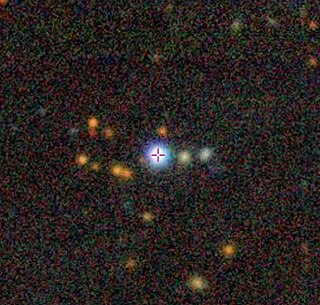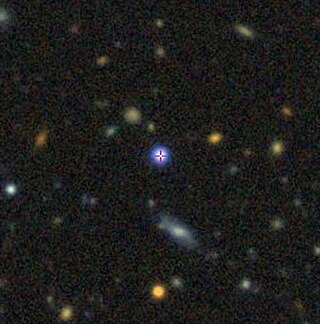Kenneth Irwin Kellermann is an American astronomer at the National Radio Astronomy Observatory. He is best known for his work on quasars. He won the Helen B. Warner Prize for Astronomy of the American Astronomical Society in 1971, and the Bruce Medal of the Astronomical Society of the Pacific in 2014.

PKS 2131-021 is a quasar and a BL Lacerate object, producing an astrophysical jet. lt is located in the constellation Aquarius and classified as a blazar, a type of active galactic nucleus whose relativistic jet points in the direction towards Earth.

PKS 0637-752 is a quasar located six billion light years in the constellation of Mensa. It is noted for having a bright and largest astrophysical jet at redshift of z = 0.651. Discovered by Einstein Observatory in 1980 through X-rays, PKS 0637-752 was the first celestial object to be observed by Chandra X-ray Observatory upon its commissioning in July 23, 1999.

PKS 0537-286, also known as QSO B0537-286, is a quasar located in the constellation Columba. With a redshift of 3.104, the object is located 11.4 billion light years away and belongs to the flat spectrum radio quasar blazar subclass (FSQR). It is one of the most luminous known high-redshift quasars.

PKS 0438-436, also known as PKS J0440-4333, is a quasar located in constellation Caelum. With a high redshift of 2.86, the object is located 11.2 billion light-years from Earth and is classified as a blazar due to its flat-spectrum radio source, (in terms of the flux density as with α < 0.5 and its optical polarization.

PKS 2215+020, known as PMN J2217+0220, is a quasar located in the Aquarius constellation. Its redshift is 3.57, meaning the object is located 11.6 billion light-years away from Earth. It is classified as a flat spectrum radio source quasar.

PKS 2126-158, also known as PKS 2126-15, is a quasar located in Capricornus. It has a redshift of 3.268000, which corresponds to the distance of 11.5 billion light years. It is classified as a gigahertz peaked-spectrum quasar (GPS) with a flat-spectrum radio source and a blazar, a type of active galaxy shooting an astrophysical jet towards Earth.

PKS 0226-559 known as PMN J0228-5546 is a quasar located in the constellation Horologium. At the redshift of 2.464, the object is roughly 10.6 billion light-years from Earth.

PKS 1345+125 known as PKS 1345+12 and 4C +12.50, is an ultraluminous infrared galaxy (ULIG) with an active galactic nucleus, located in the constellation Boötes. With a redshift of 0.121740, the galaxy is located 1.7 billion light-years from Earth.

PKS 1144-379 also known as PKS B1144-379, is a quasar located in the constellation of Centaurus. At the redshift of 1.048, the object is located nearly 8 billion light-years from Earth.

PKS 1402+044 is a quasar located in the constellation of Virgo. It has a redshift of 3.207, estimating the object to be located 11.3 billion light-years away from Earth.

PKS 0805-07 also known as PMN J0808-0751 and 4FGL J0808.2-0751, is a quasar located in the constellation of Monoceros. With a redshift of 1.83, light has taken at least 10 billion light-years to reach Earth.

PKS 0208-512 is a blazar located in the southern constellation of Eridanus. It has a redshift of 1.003 and was first discovered in 1975 by astronomers conducting the Parkes 2700 MHz survey in Australia as a bright astronomical radio source. This object is also classified highly polarized with the radio spectrum appearing to be flat, thus making it a flat-spectrum radio quasar.

PKS 0537-441 is a blazar located in the constellation of Pictor. It has a redshift of 0.896 and was discovered in 1973 by an American astronomer named Olin J. Eggen, who noted it as a luminous quasar. This is a BL Lacertae object in literature because of its featureless optical spectra as well as both a possible gravitational microlensing and a gravitationally lensed candidate. Its radio source is found compact and is characterized by a spectral peak in the gigahertz range, making it a gigahertz-peaked spectrum source (GPS).

PKS 0420-014 is a blazar located in the constellation of Eridanus. This is a high polarized quasar with a redshift of (z) 0.915, first discovered as an astronomical radio source by astronomers in 1975. The radio spectrum of this source appears to be flat, making it a flat-spectrum radio quasar (FRSQ).

PKS 0458-020 also known as PKS 0458-02, is a quasar located in the constellation of Orion. It has a redshift of (z) 2.286 and was first identified as an astronomical radio source during the radio survey conducted by Parkes Observatory in 1966. Subsequently the source was shown to display optical behavior before being classfied as a blazar via an optical polarimetry study in 1985. This source also shows radio spectrum appearing to be flat, hence making it a flat-spectrum radio quasar (FRSQ).

PKS 1510-089 is a blazar located in the constellation of Libra, categorized as a highly polarized quasar showing fast variations in polarization angles, with a redshift of (z) 0.361. It was first discovered in 1966 as an astronomical radio source during the Parkes Observatory survey in 1966. The radio spectrum of the source appears flat, thus making it a flat-spectrum radio quasar (FRSQ).

PKS 0454-234 is a blazar located in the constellation of Lepus. It is classified as a highly polarized quasar with a redshift of (z) 1.003. This object was first discovered in 1970 during a 1415 MHz continuum survey conducted by Ohio State University where it was given the designation, OF -292. The radio spectrum of this source is flat, making it a flat-spectrum radio quasar.

PKS 2255-282 is a blazar located in the constellation of Piscis Austrinus. This is a low-polarized quasar at the redshift of 0.926, first discovered in 1975 by astronomers via a spectroscopic observation. The radio spectrum of this source appears as flat, making it as a flat-spectrum quasar but also a Gigahertz Peaked Spectrum source (GPS) with turnover frequency between 22 and 37 GHz.

PKS 1127-145 is a radio-loud quasar located in the constellation of Crater. This is a Gigahertz Peaked Spectrum (GPS) object with a redshift of (z) 1.187, first discovered by astronomers in 1966. Its radio spectrum appears to be flat making it a flat-spectrum radio quasar, or an FRSQ in short.



















